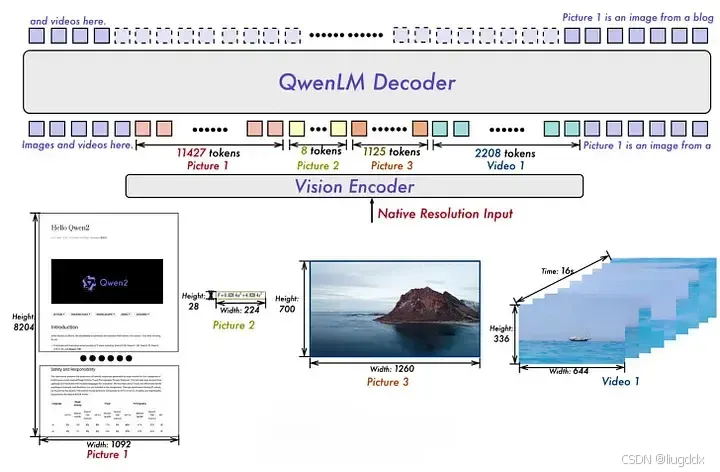 概述
概述
随着人工智能技术的迅猛发展,多模态模型在各类应用场景中展现出强大的潜力和广泛的适用性。Qwen2-VL 作为最新一代的多模态大模型,融合了视觉与语言处理能力,旨在提升复杂任务的执行效率和准确性。本指南聚焦于 Qwen2-VL 在三个关键领域的实践应用:发票数据提取、视频聊天以及基于 PDF 文档的多模态检索增强生成(RAG, Retrieval-Augmented Generation)。
多模态 RAG 的重要性
传统的生成模型主要依赖于文本数据,而多模态 RAG 则通过结合视觉信息,实现对复杂数据的更深入理解和处理。这一方法不仅提高了生成内容的相关性和准确性,还扩展了模型在实际应用中的适用范围。Qwen2-VL 通过整合图像、视频和文本数据,能够在多种场景下提供智能化的解决方案,满足企业和个人用户日益增长的需求。
发票数据提取
在财务和会计领域,发票作为重要的交易凭证,其数据的准确提取和处理对于企业的运营至关重要。传统的方法往往依赖人工录入,效率低下且易出错。Qwen2-VL 利用其强大的视觉识别和自然语言理解能力,能够自动识别发票中的关键信息,如金额、日期和供应商信息,实现高效、准确的数据提取,大幅提升工作效率并降低人为错误的风险。
视频聊天
随着远程办公和在线交流的普及,视频聊天已成为日常工作和社交的重要工具。Qwen2-VL 在视频聊天应用中,通过结合视觉和语言模型,实现智能化的实时翻译、情感分析和内容摘要等功能。此举不仅提升了沟通的便捷性和效果,还为用户提供了更加个性化和高效的交流体验。
基于 PDF 的多模态 RAG
PDF 作为一种广泛使用的文档格式,涵盖了文本、图表和图像等多种信息形式。Qwen2-VL 通过解析和理解 PDF 文档中的多模态内容,能够实现智能检索和生成。例如,在科研、法律和教育等领域,用户可以通过自然语言查询,快速获取相关信息,并生成简洁明了的总结报告。这不仅提高了信息获取的效率,还促进了知识的传播和应用。
Qwen2-VL 架构
下面这张图就是Qwen2-VL的架构图。
到目前为止,已知的是 Qwen2-VL 使用带有 Vision Transformer 的 Qwen2-LM — 能够处理图像和视频。此外,Qwen2-VL 还推出了新颖的多模态旋转位置嵌入 s( M-ROPE )。这是 ROPE 嵌入的一种变体,它将位置嵌入分解为多个部分 。
Qwen2-VL 支持多种语言,包括大多数欧洲语言、日语、韩语、中文和阿拉伯语。更多细节参考官方文档。
项目 1:将发票数据提取为 JSON 格式
在这个小型项目中,我们将从下面的发票中提取财务和个人信息 — JSON 格式:
首先,安装必要的库:
pip install git+https://github.com/huggingface/transformers accelerate
pip install qwen-vl-utils
接下来,我们下载我们的文件:
import urllib.request
# 发票图片地址
url = "<http://cwb.stdusfc.edu.cn/images/2015/cw112701.png>"
# 下载发票
file_name = url.split('/')[-1]
urllib.request.urlretrieve(url, file_name)
print(f"Downloaded file name: {file_name}")
# Downloaded file name: cw112701.png
然后,我们将安装 Qwen2-VL-7B-Instruct 。
from transformers import Qwen2VLForConditionalGeneration, AutoTokenizer, AutoProcessor
from qwen_vl_utils import process_vision_info
import json
model_name = "Qwen/Qwen2-VL-7B-Instruct"
model = Qwen2VLForConditionalGeneration.from_pretrained(
model_name,
torch_dtype="auto",
device_map="auto"
)
processor = AutoProcessor.from_pretrained(
model_name
)
在模型下载并放入内存后,我们可以发送我们的请求。一些额外提示:
- 至少使用原始图像尺寸 :确保至少使用图像的原始尺寸以获得最佳效果(
resized_height & resized_width arguments参数) - 较大的尺寸 : 在质量较差的图像中,尺寸稍大可以提高准确性,但会增加 VRAM 的使用量。相应地调整:
我们将使用 Qwen2-VL 的聊天模板,并提示如下:
"检索项目内容,金额,付款单位,时间,发票代码,发票号码。响应必须是 JSON 格式"
messages = [
{
"role": "user",
"content": [
{
"type": "image",
"image": file_name,
"resized_height": 696,
"resized_width": 943,
},
{
"type": "text",
"text": "检索项目内容,金额,付款单位,时间,发票代码,发票号码。响应必须是 JSON 格式"
}
]
}
]
text = processor.apply_chat_template(
messages, tokenize=False, add_generation_prompt=True
)
image_inputs, video_inputs = process_vision_info(messages)
inputs = processor(
text=[text],
images=image_inputs,
videos=video_inputs,
padding=True,
return_tensors="pt",
)
inputs = inputs.to("cuda")
generated_ids = model.generate(**inputs, max_new_tokens=512)
generated_ids_trimmed = [
out_ids[len(in_ids) :] for in_ids, out_ids in zip(inputs.input_ids, generated_ids)
]
output_text = processor.batch_decode(
generated_ids_trimmed, skip_special_tokens=True, clean_up_tokenization_spaces=True)
output_text
我们得到以下输出:
['```json\\n{\\n "项目内容": [\\n "钢尺 30 x11.5",\\n "美工刀 60 x2",\\n "腊线 30 x14"\\n ],\\n "金额": [\\n "345.00",\\n "200.00",\\n "420.00"\\n ],\\n "付款单位": "石家庄铁道大学四方学院",\\n "时间": "2015年5月11日",\\n "发票代码": "113001464131",\\n "发票号码": "09404611"\\n}\\n```']
你可以使用以下代码来修复潜在错误并设置模型的 JSON 输出格式:
json_string = output_text[0]
json_string = json_string.strip("[]'")
json_string = json_string.replace("```json\\n", "").replace("\\n```", "")
json_string = json_string.replace("'", "")
try:
formatted_json = json.loads(json_string)
print(json.dumps(formatted_json, indent=3, ensure_ascii=False))
except json.JSONDecodeError as e:
print("Not valid JSON format:", e)
通过将结果与上述发票进行比较,我们注意到:
- 该模型的输出准确率非常高 — 它准确地提取了所有相关信息!
- 尽管图像质量很差并且表格中嵌入了数据!
- 较小的 Qwen2-VL 在这里表现良好,但对于更复杂的图像或手写文本,你可能需要更大的模型,例如
Qwen2-VL-72B.
项目 2:通过视频聊天
Qwen2-VL 还可以提取信息并与视频交互。
在这个项目中,我们将使用一个简短的 B站 视频 —《这一段毫无表演痕迹 堪称经典》 :
## 下载B站视频
pip install yt-dlp
按如下方式下载:
import yt_dlp
import os
def download_bilibili_video(url, download_path='downloads', fmt='100047+30280', cookiefile=None):
# 创建下载目录(如果不存在)
if not os.path.exists(download_path):
os.makedirs(download_path)
ydl_opts = {
'outtmpl': os.path.join(download_path, '%(title)s.%(ext)s'),
'format': fmt, # 指定视频和音频的格式ID
'noplaylist': True,
'merge_output_format': 'mp4', # 合并为mp4格式
}
if cookiefile:
ydl_opts['cookiefile'] = cookiefile
with yt_dlp.YoutubeDL(ydl_opts) as ydl:
ydl.download([url])
video_url = '<https://www.bilibili.com/video/BV1us41eBERp>' # 替换为你要下载的视频URL
download_directory = './downloads' # 替换为你希望保存视频的目录
# 如果需要使用Cookies进行认证,取消下行注释并提供Cookies文件路径
# cookies_path = 'path_to_cookies.txt'
# download_bilibili_video(video_url, download_directory, fmt='100047+30280', cookiefile=cookies_path)
# 如果不需要认证,使用以下行
download_bilibili_video(video_url, download_directory, fmt='100046+30280')
file_name = './downloads/这一段毫无表演痕迹 堪称经典.mp4'
我们将再次使用Qwen2-VL-7B,因为它的资源密集度较低。
from transformers import Qwen2VLForConditionalGeneration, AutoTokenizer, AutoProcessor
model_name = "Qwen/Qwen2-VL-7B-Instruct"
model = Qwen2VLForConditionalGeneration.from_pretrained(
model_name,
torch_dtype="auto",
##attn_implementation="flash_attention_2", #use flash-attention2 if your gpu card supports it (Free Colab's T4 does not support it)
device_map="auto",
)
processor = AutoProcessor.from_pretrained(
model_name
)
我们定义函数 chat_with_video ,它接受调整后的视频尺寸、每秒帧数和我们将向 Qwen 询问的文本消息:
def chat_with_video(file_name, query, video_width, video_height, fps=1.0):
messages = [
{
"role": "user",
"content": [
{
"type": "video",
"video": file_name,
"max_pixels": video_width * video_height,
"fps": 1.0,
},
{"type": "text", "text": query},
],
}
]
text = processor.apply_chat_template(
messages, tokenize=False, add_generation_prompt=True
)
image_inputs, video_inputs = process_vision_info(messages)
inputs = processor(
text=[text],
images=image_inputs,
videos=video_inputs,
padding=True,
return_tensors="pt",
)
inputs = inputs.to("cuda")
generated_ids = model.generate(**inputs, max_new_tokens=150)
generated_ids_trimmed = [
out_ids[len(in_ids) :] for in_ids, out_ids in zip(inputs.input_ids, generated_ids)
]
output_text = processor.batch_decode(
generated_ids_trimmed, skip_special_tokens=True, clean_up_tokenization_spaces=False
)
return output_text
让我们问一下模型:
output_text = chat_with_video(file_name, "这个视频展示了什么?", 360, 360,fps=0.5)
>>['这个视频展示了两个人在餐馆里吃饭的场景。其中一个人穿着蓝色衣服,戴着帽子,另一个人穿着棕色外套。他们用筷子夹着食物,喝着汤,看起来非常享受。']
还有另一个问题:
output_text = chat_with_video(file_name, "谁付的钱?", 360, 360,fps=0.5)
>>['根据视频内容,最后是穿棕色大衣的男子付了钱。']
耗费gpu资源情况:
令人惊讶的是,该模型准确地回答了这两个问题!
一些额外的说明:
- 增加视频的高度、宽度和帧速率 (fps) 通常会提高准确性,但需要更多的 GPU VRAM。
- Qwen2-VL 可以处理超过 20 分钟的视频,但是GPU资源需求很大。
- 从我的实验来看,Qwen2-VL-7B 在准确性和资源需求 (GPU VRAM) 之间提供了最佳平衡。
项目 3:多模态 RAG
在本项目中,我们将 Qwen2-VL 与另一个模型 ColPali 相结合,以对 PDF 执行 RAG。ColPali 是一个文档检索模型,包含一个 PaliGemma-3B 模型(也是 VLM)和一个 Gemma-2B。ColPali 的作用是执行文档检索部分并创建一个多向量文档存储:
- 在我们的例子中,流程如下:
- 将每个 PDF 页面转换为图像。
- 将图像推送到 ColPali 中,以存储每个页面的多向量表示。
- 向 ColPali 提交文本查询以检索相关图像。
- 将文本查询和相关图像提交给 Qwen2-VL 以获取答案。
我们将使用 Byaldi 库创建图像向量存储。Byaldi 加载 ColPali(以及使用 API 的类似模型)。我们还将使用 pdf2image 将 PDF 转换为图像:
让我们从安装必要的库开始:
#pip install --upgrade byaldi
pip install byaldi==0.0.5
pip install -q git+https://github.com/huggingface/transformers.git qwen-vl-utils pdf2image
## pdf2image 必要的工具
!sudo apt-get install -y poppler-utils
我们将为此项目下载一个 1 页的 PDF — 一个用于节省 VRAM 的小文件。
import urllib.request
# We will use this pdf:
url = "<http://ep.ycwb.com/epaper/ycwb/resfile/2020-01-28/A08/ycwb20200128A08.pdf>"
# Download the file
pdf_filepath = url.split('/')[-1]
urllib.request.urlretrieve(url, pdf_filepath)
print(f"Downloaded file name: {pdf_filepath}")
由于模型处理的是图像,而不是 PDF 文件,因此我们将每个页面转换为图像。如果要在 Jupyter/Colab 中可视化图像,请运行以下代码:
from PIL import Image as PILImage
from pdf2image import convert_from_path
from IPython.display import display
images = convert_from_path(pdf_filepath)
for page_number, page in enumerate(images):
resized_image = page.resize((600, 800), PILImage.Resampling.LANCZOS)
print(f"Page {page_number + 1}:")
display(resized_image)
以下是我们 PDF 中的一张图片:
接下来,我们加载 ColPali 并构建我们的索引存储:
from transformers import Qwen2VLForConditionalGeneration, AutoTokenizer, AutoProcessor
from qwen_vl_utils import process_vision_info
import torch
vlm_name = "Qwen/Qwen2-VL-7B-Instruct"
model = Qwen2VLForConditionalGeneration.from_pretrained(vlm_name,
torch_dtype="auto",
device_map="auto")
processor = AutoProcessor.from_pretrained(vlm_name)
该函数extract_answer_from_pdf执行以下操作:
- 给定一个文本查询,我们要求 Colpali 检索最相关的图像 (k=1)。该图像表示一个 PDF 页面。
- 给定文本查询和相关图像,我们要求 Qwen-VL-7B 执行图像识别并提供文本查询的答案:
- 该函数返回答案 (output_text)、包含答案的页码以及相关的图像/页面
def extract_answer_from_pdf(text_query):
results = RAG.search(text_query, k=1)
print(results)
image_index = results[0]["page_num"] - 1
messages = [
{
"role": "user",
"content": [
{
"type": "image",
"image": images[image_index], ## 包含检索到的 pdf 页面作为图像
"resized_height": 527,
"resized_width": 522,
},
{"type": "text", "text": text_query},
],
}
]
text = processor.apply_chat_template(
messages, tokenize=False, add_generation_prompt=True
)
image_inputs, video_inputs = process_vision_info(messages)
inputs = processor(
text=[text],
images=image_inputs,
videos=video_inputs,
padding=True,
return_tensors="pt",
)
inputs = inputs.to(device)
generated_ids = model.generate(**inputs, max_new_tokens=50)
## 从答案中删除提示
generated_ids_trimmed = [
out_ids[len(in_ids) :] for in_ids, out_ids in zip(inputs.input_ids, generated_ids)
]
output_text = processor.batch_decode(
generated_ids_trimmed, skip_special_tokens=True, clean_up_tokenization_spaces=False
)
return output_text, results[0].page_num , images[image_index]
让我们问问我们的模型:
text_query = "这篇报道的时间是什么?"
output_text, page_number, image = extract_answer_from_pdf(text_query)
print("\\n\\n")
print(output_text)
>>>
['2020-01-28']
模型是正确的!报道的时间是2020-01-28。让我们再问一个问题:
text_query = "科比的直升机坠机地点在哪?"
output_text, page_number, image = extract_answer_from_pdf(text_query)
print("\\n\\n")
print(output_text)
>>>
['T事故发生在美国加利福尼亚州卡拉巴萨斯市,在洛杉矶以西大约 30 公里.']
- 我们可以使用多个 PDF 吗?
是的!只需将多个 PDF 放在访问的RAG.index()文件夹中即可。
- 我们可以检索多张图像吗?
是的。在这种情况下,我们只检索了最相关的图像 (k=1)。你可以通过设置 k=2 来检索更多图像,然后将两张图像都传递给 Qwen 进行处理。
chat_template = [
{
"role": "user",
"content": [
{
"type": "image",
"image": image[0],
},
{
"type": "image",
"image": image[1],
}
{"type": "text", "text": text_query},
],
}
]
但是,添加更多 PDF 或检索多个页面需要更多的资源。
结束语
本文探讨了 Qwen2-VL 在图像、视频和文档检索任务中的应用。
对于更复杂的情况,你可以选择模型的更大版本或量化版本——这些版本的大小更小,质量损失最小。
本站资源均来自互联网,仅供研究学习,禁止违法使用和商用,产生法律纠纷本站概不负责!如果侵犯了您的权益请与我们联系!
转载请注明出处: 免费源码网-免费的源码资源网站 » Qwen2-VL:发票数据提取、视频聊天和使用 PDF 的多模态 RAG 的实践指南

发表评论 取消回复